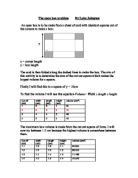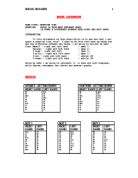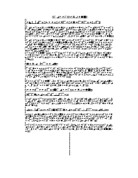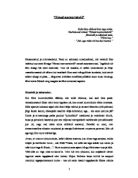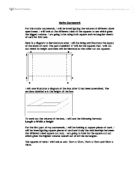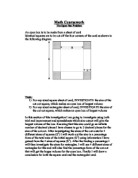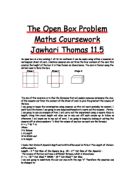Tbe Open Box Problem
The open box problem By Luke Johnston An open box is to be made from a sheet of card with identical squares cut of the corners to make a box: y x = corner length y = box length The card is then folded along the dashed lines to make the box. The aim of this activity is to determine the size of the cut out square which makes the largest volume for a square. Firstly I will find this in a square of y = 10cm To find the volume I will use this equation-Volume= Width x length x height Cut off (cm) width (cm) length (cm) height (cm) volume (cm²) 8 8 64 2 6 6 2 72 3 4 4 3 48 4 2 2 4 6 The maximum box volume is made from the cut out square of 2cms. I will now try between 1-2 cm because the highest volume is somewhere between them. Cut off (cm) width (cm) length (cm) height (cm) volume (cm²) .1 7.8 7.8 .1 66.924 .2 7.6 7.6 .2 69.312 .3 7.4 7.4 .3 71.188 .4 7.2 7.2 .4 72.576 .5 7 7 .5 73.5 .6 6.8 6.8 .6 73.984 .7 6.6 6.6 .7 74.052 .8 6.4 6.4 .8 73.728 .9 6.2 6.2 .9 73.036 2 6 6 2 72 The highest value of x is 1.7, but once again I will find a volume even higher in the 10 by 10 box by going into two decimal places. Cut off (cm) width (cm) length (cm) height (cm) volume (cm²) .61 6.78 6.78 .61 74.0091 .62 6.76 6.76 .62 74.0301 .63 6.74 6.74 .63 74.047 .64 6.72 6.72 .64
In this coursework my task description is to see how fast I can catch a reaction time ruler. I have to do this with both my hands and see the difference between the hands.
MATHS COURSEWORK TASK TITLE: REACTION TIME QUESTION: WHICH IS YOUR MOST DOMINANT HAND? IS THERE A DIFFERENCE BETWEEN YOUR RIGHT AND LEFT HAND? INTRODUCTION: In this coursework my task description is to see how fast I can catch a reaction time ruler. I have to do this with both my hands and see the difference between the hands. I am going to collect my data from: Myself - right and left hand - year 11 Partner - right and left hand - year 11 3 boys - right and left - year 11 3 girls - right and left hand - year 11 3 men - right and left hand - adults 18+ 3 women - right and left hand - adults 18+ Using my data I am going to represent it in stem and leaf diagrams, tally charts, averages, bar charts and scatter graphs. RESULTS MYSELF - SITTING DOWN PARTNER - SITTING DOWN RIGHT HAND LEFT HAND RIGHT HAND LEFT HAND 9 5 6.5 7 6 2 7.5 7 6 7 9.5 5 2 23.5 6 5 7 6 4 7 9 7 6.5 8 6 7.5 6.5 3 3 2 8.5 6 6.5 1.5 9 2 7 4 3 8 BOY 1 BOY 2 BOY 3 RIGHT HAND LEFT HAND RIGHT HAND LEFT HAND RIGHT HAND LEFT HAND 3.5 3 5 7.5 9 7 8 5.5 5 6.5 5 20 8 2 5 3 8 7 8 4 20 21 9 7 6 7 2 6 2 0 21.5 8.5 9 3 7.5 1 7.5 7.5 8 6 20 5 21 3 5 6 7 4 6 3 4 3 21 4 7.5 3 6 9 4 5 GIRL 1 GIRL 2 GIRL 3 RIGHT HAND LEFT HAND RIGHT HAND
Global warming is an important factor because every one in the world but most importantly for me it will effect all of my relatives, as it is predicted that countries such as Bangladesh will be totally fooled due to global warming.
???????????? ????????????????????????????? ??????????????????????????????????????????????????????????????????????????????????????????????????????????????????????????????????????????????????????????????????????????????????????????????????????????????????????????????????????? ??????????????????????????????????????????????????????????????????????????????????????????????????????????????????????????????????????????????????????????????????????????????????????????????????????????????????????????????????????????????????? ?????????????????????????????????????????????????????????????????????????????????????????????????????????????????????????????????????????? ?????????? ???????????????????????????????????????????????????????????????????????????????????????????????????????????????????????????????????????????????????????????????????????????????????????????????????????????????? ?????????????????????????????????????????????????????????????????????????????????????????????????????????????????????????????? ????????????????????????? ????????????????? ???????????????????????????????????????????????????????????????????????????????????????????????????????????????????????????????????????????????? ???????????????????????????????????
Kunstnik ja dekoraator.
"Nimed marmortahvlil" Kaks kitse söövad kino taga rohtu. Nad leiavad rohust "Nimed marmortahvlil" filmirulli ja näksivad seda. - "Päris hea." - "Jah, aga mitte nii hea kui raamat." Kauaoodatud ja enimvaadatud. Need on esimesed omadussõnad, mis varakult üles haibitud uue eesti filmiga "Nimed marmortahvlil" esmalt assotseeruvad. Tegelikult oli film ikkagi üle eesti keskmise. Tore oli vaadata, et sellist uimerdamist ja tühje maastikuvaateid oli vähem kui tavaliselt ühes eesti mängufilmis kombeks, kuid ainult sellest ikkagi ei piisa... Järgnevas kriitilises analüüsis püüabki autor anda hinnangu filmi kohta üldiselt ning vaagida ka filmi erinevaid aspekte. Kunstnik ja dekoraator. Kui filmi kunstnikutööst rääkida, siis tekib küsimus, kas seal ikka peale tavadekoraatori üldse mõni teine tegelane oli, kes ennast kunstnikuks võiks nimetada. Kõik ajastule kohased asjad olid ilusti välja valitud ja kenasti tähestiku (või pikkuse) järgi lauale laotud, ebavajalik kaadrist välja lohistatud, aga... kes seda uskuma jäi? Hoole ja armastusega paika pandud "juhuslikult" naalduvad ja vedelevad tünnid, lauad ja jahukotid laastatud poe ees mõjuvad vastupidiselt taotletavale juhuslikkusele just nii, nagu nad oleks sinna sihilikult asetatud. Detailid on need, mis ekraanimaailma elusaks muudavad ja vaataja ümbritsevat unustama panevad. Siin oli aga tegu
Open Box Investigation
25th January Math | Sara Ellis Introduction: The open box problem is regarding an open box made from a sheet of card. Identical sized squares are removed from the four corners of the card (shown in the diagram below). The aim of this investigation is to verify the size of the square removed that would make the largest volume for any given sheet of card, both square and rectangular. I will do this by finding a general formula which would work for finding the best size of square cut. Square Boxes In order to determine the size of square cut off from the card, I tried many different sizes on square boxes to find the size that would give the largest volume. To find the volume I have used the formula: Volume = Length x Width x Height To find the length and width I take two of the length of square cut from the total length/width of the box. The height is the same as the side length of square cut. Below are my results: 0x10 Square Side Length of Square (cm) 2 3 4 Length of Box 8 6 4 2 Width of Box 8 6 4 2 Height 2 3 4 Volume 64 72 48 6 To find the more precise length of square which I should cut, I have used the upper and lower bounds of the best length of square in the table above (in this case, 2cm). Side Length of Square .5 .6 .7 .8 .9 2 2.1 Length of Box 7 6.8 6.6 6.4 6.2 6 5.8 Width of Box 7 6.8 6.6 6.4 6.2 6 5.8
Maths Coursework
Maths Coursework For this maths coursework, I will be investigating the volume of different sized open boxes. I will look at the different sizes of the squares to see which gives the biggest volume. I am going to be using both square and rectangular sheets of card for this task. Here is a diagram to demonstrate what I will be doing and illustrate the layout of the sheet of card. The parts labelled 'x' will be the squares that I will cut out which its height and sizes will be identical as the other cut out squares. x x x x x x x x I will now illustrate a diagram of the box after it has been assembled. The sections labelled x is the height of the box. To work out the volume of the box, I will use the following formula: Length x Width x Height For the first part of my coursework, I will be looking at square pieces of card. I will be investigating square pieces of card and study the relationships between the different sized square cut outs. I am going to look for the square cut out which gives the highest volume overall out of all the rectangles. The squares of sizes I will look at are: 12cm x 12cm, 15cm x 15cm and 18cm x 18cm. The first square I will look at
The Open Box Problem
Math Coursework The Open Box Problem An open box is to be made from a sheet of card Identical squares are to be cut off the four corners of the card as shown in the following diagram Task: ) For any sized square sheet of card, INVESTIGATE the size of the cut out square, which makes an open box of largest volume 2) For any sized rectangular sheet of card, INVESTIGATE the size of the cut out square, which makes an open box of largest volume In this section of this investigation I am going to investigate using both trial and improvement and spreadsheets which size cutout will give the largest volume of the box. Knowing that this size could go an infinite number of decimal places I have chosen to go to 3 decimal places for the size of the cut out. After investigating the sizes of the cut-outs for 4 different sizes of squares (S2) I will work out the size in a percentage form of the total area of the initial square (S2) using information I have gained from the 4 sizes of squares (S2). After the finding a percentage I will then investigate the sizes for rectangles. I will use 4 different sizes of rectangles for this and will also find the percentage form of the cut out that will get the larges volume for the open box. Finally I will draw a conclusion for both the square card and the rectangular card. The Square I will first use a 10 x 10 square S X B V 0 8 64 0 2
The Open Box Problem
The Open Box Problem An open box is to be made from a sheet of card. Identical squares are cut off the four corners of the card, as shown below.(fig 1) FIG 1 The card is then folded along the dotted lines to make the box. The main aim is to determine the size of the square cut which makes the volume of the box as large as possible for any given rectangular sheet of card. I am going to begin by investigating a square with a side length of 20 cm. Using this side length, the maximum whole number I can cut off each corner is 9cm, as otherwise I would not have any box left. I am going to begin by looking into whole numbers being cut out of the box corners. The formula that needs to be used to get the volume of a box is: ( * = multiply) Volume = Length * Width * Height If I am to use a square of side length 20cm, then I can calculate the side lengths minus the cut out squares using the following equation. Volume = Length -- (2 * Cut Out) * Width -- (2 * Cut Out) * Height Using a square, both the length & the width are equal. I am using a length/width of 20cm. I am going to call the cut out ""x."" Therefore the equation can be changed to: Volume = 20 -- (2x) * 20 -- (2x) * Height If I were using a cut out of length 1cm, the equation for this would be as follows: Volume = 20 -- (2 * 1) * 20 -- (2 * 1) * 1 So we can work out through this method that the volume
The Open Box Problem.
Third Problem,The Open Box Problem In this investigation, I will be investigating the same as I did in the 'Second Investigation'. This will be the maximum volume, which can be made from a certain size rectangle piece of card, with different size sections cut from their corners. The type of cuboids I will be using are opened topped boxes. I will keep one side the same all of the time. The size sections that I will be cutting from the rectangle piece of card will all be the same size. The section sizes will go up to the maximum length possible for the piece of card. Prediction During this investigation, I will not account for the `tabs', which would normally be needed to hold the box sides together. I still predict that to obtain the largest volume from a certain size, Rectangle, piece of card; the length of the section cut from the corner, needs to equal a sixth of side A. Side B can be anything. The only difference between this one and the last experiment will be that I will have only one variable, which I hope will give a rule to find the size of cut out needed to leave the maximum volume cuboid. X = ^1/[6]A 4m by 3cm, piece of card. R e s u l t s Length of the section (cm) Height of the section (cm) Depth of the section (cm) Width of the section (cm) Volume of the cube (cm^3) 0.1 0.1 2.8 3.8 1.064 0.2 0.2 2.6 3.6 1.872 0.3 0.3 2.4
The Open Box Problem
The Open Box Problem Maths Coursework Jawhari Thomas 11.5 An open box is a box missing 1 of its six surfaces it can be made using either a squared or rectangular sheet of card. Identical squares are cut from the four corners of the card this creates the height of the box it is then folded as shown below. The card is folded along the dotted lines to form the box. Stage 1 Stage 2 Stage 3 The aim of this exercise is to find the formulae that will enable someone determine the size of the squares cut from the corners of the sheet of card to give the greatest the volume of the box. I am going to begin the investigation using squares, as this will most probably be easiest. I won't build the boxes I am going to use simple mathematics to work out the volumes. Firstly I am going to use an example of how I will carry out the experiment using a square 20cm in length. Using this sized length will allow me to only cut off each corner up to 9.9cm as otherwise I will cause me to run out of card. I am going to begin by looking at cutting the squares off as whole numbers. To find the volume of any box we must use the formula: V = L * W * H When: V is Volume L is Length W is Width and H is Height I know that the both square's length and width will be equal to 20 but The Length of the box will be equal to Length - 2 * Cut Size of the Square (e.g. 20 - 2 * Cut Size of the


